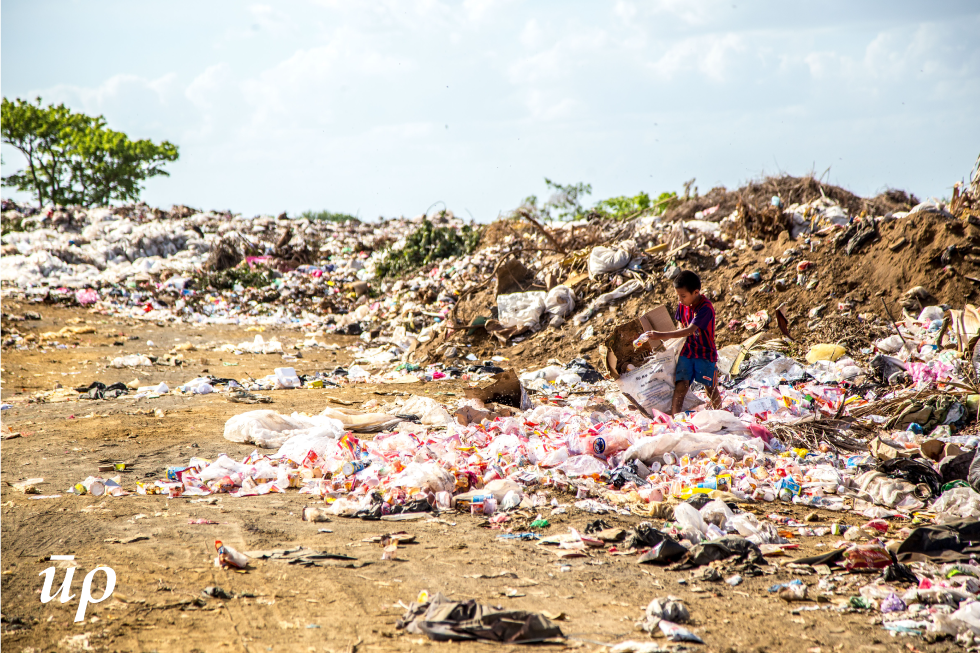Bhanpur Landfill Site Bhopal
Black and white constructs plethora of metaphors in mind. ‘Landfill gulls’, hawks and stench, mark their territory over the skies of Bhanpur Landfill. This area signifies and marks the decaying rotten side of the city. An unplanned unscientific dumping of waste spread across 57.80 acres, has been continuously exploited for more than four decades.
At 3.30 PM, I first met Julfukar Ji. He collects waste from the households of Bhanpur area. On being confronted with any problems he’s facing, in the neighborhood, he replied with a straight-faced “No”. He was burning plastics and his surroundings were populated by flies all over. Further inquiries about the conditions of water, he suggested drinking water from his water bottle which itself was surrounded by heaps of trash. Hesitated, I gulped a few drops down and could not find any problems with the taste or color. He fills his water bottle from the tank placed by Nagar Nigam (Municipal Corporation of) Bhopal in his premises.

Picture – Hermes Rivera | Unsplash
Later at 3:50 PM, I met Raghunath Ji sipping tea with his friend and grandson. He’s a local resident and been living here for at least 10 years and owns a Tobacco Tapri (stall). It is located adjacent to the railway lines and just behind it lies 6-story high dumping mountain – as he and his grandson call it. He mentioned that there have been ministerial visits every election season, promising removal of the trash but to no avail.
Mentioning the fires that break out every now and then, the grandson giggled and spoke about his “Bhaiya” (random neighborhood acquaintance) who wraps a towel around his face every other night. The grandfather joined to tell that, “these fires usually break out in nights but no such accidents take place on roads or in neighborhoods. All the houses are filled up with smoke, tears roll through their eyes and sometimes it gives a burning sensation.”
Localities have also signed petitions and filled numerous forms but no action has been taken yet.
Though, on being queried about any health issues, he explains that he fell ill last 4 years back and recovered without visiting any hospitals. He further asserted that they have grown used to this scenario and flies, drain, smoke, smog are inclusive elements of their (miserable) life. Water, they tell, is usually a major woe in such areas. On inquiring about it, Raghunath Ji explained that now that their water lines are supplied from Narmada river, there is access to clean water.
While digging more information about Bhanpur landfill, I came across an environmentalist, Subhash C Pandey, who has filed a lawsuit against Nagar Nigam Bhopal for illegally dumping at Bhanpur site and he is the reason why Bhanpur is getting clean drinking water from the Narmada.
After the conversation with Raghunath Ji, I decided to spend some time over the bridge to understand more about rag-pickers and the garbage itself. Hungry cows have climbed high in search of food and stray dog find cozy spaces in between them. At the nodes, women were informally involved with the process of segregation of waste, while their kids continued playing with discarded water bottles.
A sturdy young kid with a black shoe in right and white shoe in left was carrying tons of Bhopal’s waste over his shoulders, delivering it at the other node across the railway track to other rag-pickers.
Walking meters with their rugged shoes carrying tonnes of waste throughout the day. Climbing mountains, inhaling poisonous gases and carefully walking over the sulky contours earns them petty living which fills their stomachs enough to carry for another day.
Before finally turning my back to the poison I’ve (we have) generated, I saw a beautiful vista of women washing clothes over a black pond and their informal settlements lie nearby. I met Sunny, a proud Jhuggi owner. On being asked about the sanitation conditions, he ensured me that they are building a Sulabh complex (community toilet facility) which will be complete anytime and pointed towards the portable toilets they were using, meanwhile. He himself had no complaints about the living standards and brags his daily average living of Rs. 150 – Rs. 250, he earned by selling scrap.
While clicking a picture from highway running parallel to railway lines, I witnessed smoke rising over mountains, silhouettes of adolescent rag pickers and ‘landfill gulls’ perched over their poisoned food.
Every day, the city of Bhopal generates 800-1000 tonnes solid waste. The city has not yet recovered from the biggest industrial disaster which was caused by foreign elements, but this time we are poisoning our own lands.
Bhanpur landfill shall be scientifically capped and closed soon as ‘promised’. Bhopal’s waste is to be directed to a new site at Adampur which is to be a planned facility & shall generate electricity and manure. In the same light, bio-fertilizer plant at Bhanpur is a part of debris itself and is in ruins. And thus ‘abode of scavengers’ shall be changed and path for further ‘development’ be cleared.

Leave a Reply
You must be logged in to post a comment.